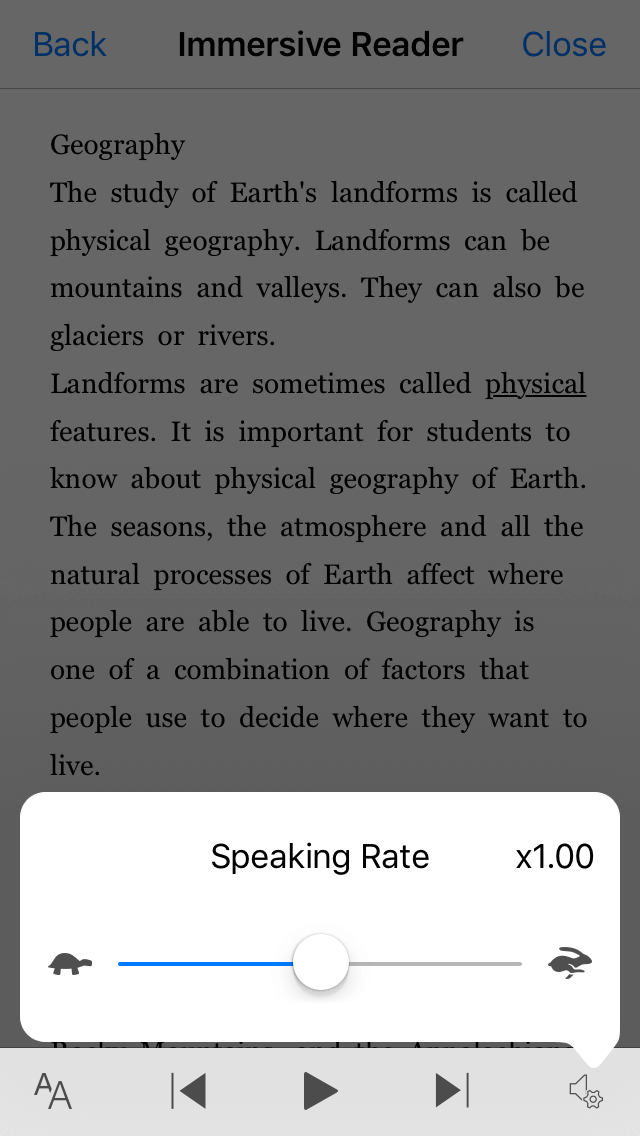This article is for people who use a screen reader program such as Windows Narrator, JAWS, or NVDA with Windows tools or features and Microsoft 365 products. This article is part of the Accessibility help & learning content set where you can find more accessibility information on our apps. For general help, visit Microsoft Support.
Note: This article has done its job, and will be retiring soon. To prevent "Page not found" woes, we're removing links we know about. If you've created links to this page, please remove them, and together we'll keep the web connected.
Use Microsoft Lens with the accessibility features of your iPhone, such as VoiceOver, the built-in iOS screen reader, to capture notes and information from whiteboards, menus, signs, handwritten memos, or anything with a lot of text. You can also capture sketches, drawings and equations, too, and even images without text.
Your iPhone has accessibility settings that can help you use Microsoft Lens in a way that works for you. Go to Settings > General > Accessibility Settings to turn on features like Zoom, Speak Selection, and to change the size of text.
Notes:
-
New Microsoft 365 features are released gradually to Microsoft 365 subscribers, so your app might not have these features yet. To learn how you can get new features faster, join the Office Insider program.
-
This topic assumes that you are using the built-in iOS screen reader, VoiceOver. To learn more about using VoiceOver, visit Apple accessibility.
In this topic
VoiceOver
VoiceOver is the built-in screen reader on the iPhone.
Turn on VoiceOver
Note: This topic assumes you’re using the default gestures, not customized AssistiveTouch settings.
-
Press the Home button.
-
Tap Settings, tap General, tap Accessibility, and then tap VoiceOver.
-
Turn on VoiceOver.
Create a Home button shortcut to VoiceOver
-
Press the Home button.
-
Tap Settings, tap General, and then tap Accessibility.
-
Scroll down and then tap Accessibility Shortcut.
-
Tap VoiceOver.
To use the shortcut to turn VoiceOver on or off, triple-tap the Home button.
Immersive Reader
Immersive Reader is a tool that provides a full screen reading experience and helps you focus on the content of your documents.
Open Immersive Reader
-
After capturing and editing an image in Microsoft Lens, swipe right or left until you hear “Done button,” and then double-tap the screen.
-
Swipe right or left until you hear “Immersive Reader button,” and then double-tap the screen. It can take a few moments to scan texts from images, so don't worry if nothing happens immediately.
Work with Immersive Reader
When Immersive Reader has opened, the screen shows the text from the images you scanned. Do one of the following:
-
To have the page dictated to you, swipe right or left until you hear “Play button,” and then double-tap the screen. Each word is highlighted as the narrator recites the document aloud.
-
To pause the dictation, swipe right or left until you hear “Pause button,” and then double-tap the screen.
-
To skip some of the audio and start reading from the bottom of the page, swipe right or left until you hear “Skip forward button,” and then double-tap the screen.
-
To rewind the audio, swipe right or left until you hear “Rewind button,” and then double-tap the screen.
The playback experience works best in English.

Change the text settings
The Immersive Reader has several options to help you consume the text on the screen in the way that you want to. To open the text settings, swipe right or left until you hear “Text button,” double-tap the screen, and do one of the following:
-
To change the Wide Text Spacing toggle setting, double-tap the screen. This setting defines the font spacing. Regular spacing is used in most books and documents. Wide spacing, however, increases the space between letters, as well as the space between lines.

-
To change the text size, swipe right or left until you hear “Increase text size” or “Decrease text size,” and double-tap the screen to increase or decrease the size by a small amount.
-
Try the text size settings in combination with the text spacing until you find a combination that works for you.
Voice options
To change the speaking speed of Immersive Reader, swipe right or left until you hear “Speak button,” double-tap the screen, and swipe up or down to adjust the speed in the Speaking Rate slider. The slider lets you control the speed to your personal preference. To dismiss the slider popup, tap the screen. When you hear “Dismiss popup”, double-tap the screen.

See also
Use a screen reader to explore and navigate Microsoft Lens
Basic tasks using a screen reader with Microsoft Lens
Set up your device to work with accessibility in Microsoft 365
Technical support for customers with disabilities
Microsoft wants to provide the best possible experience for all our customers. If you have a disability or questions related to accessibility, please contact the Microsoft Disability Answer Desk for technical assistance. The Disability Answer Desk support team is trained in using many popular assistive technologies and can offer assistance in English, Spanish, French, and American Sign Language. Please go to the Microsoft Disability Answer Desk site to find out the contact details for your region.
If you are a government, commercial, or enterprise user, please contact the enterprise Disability Answer Desk.











